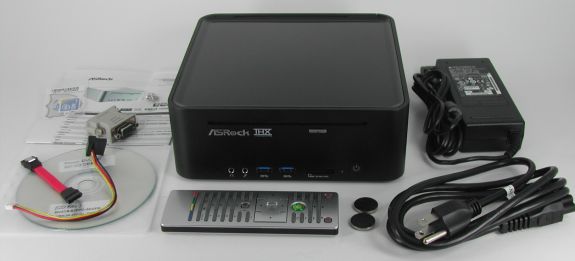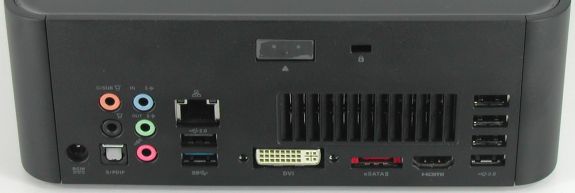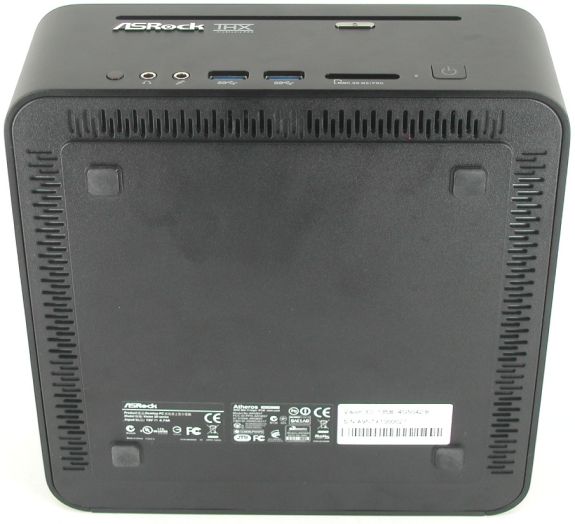ASRock's High-End Vision 3D HTPC Reviewed
by Ganesh T S on October 3, 2010 10:20 AM ESTThe ASRock Vision 3D HTPC package is similar in size to the Core 100 package.
Apart from the main unit, the package also bundles the following:
- 90W AC / DC Adapter
- SATA and power cables, as well as mounting screws for a 2.5" hard disk
- DVI to VGA adapter
- MCE remote and a couple of CR232 batteries.
- Manual with instructions for disassembling and replacing the MXM card
- CDs with drivers and ASRock utilities, as well as PowerDVD 3D BD Player (OEM version)
While the Core 100 and ION 330 shared a similar industrial design, ASRock realized that a high end HTPC needed a shift in appearance. It now brings a Mac Mini look, though the dimensions are still the same as that of the Core 100 and ION 330. The edges are no longer abrupt, and the slimline BD drive has been replaced by a slot loading one. These are exactly the points with which we found issues in the Core 100 review. Of course, people who are concerned with the aesthetics may object to the large number of ports and imprints on the front side of the unit. In a future design, ASRock may probably shift the imprints to the top panel and hide the front ports with a full width hinged door of sorts.
Like the Core 100, the front panel has two audio jacks and two USB ports. In addition, there is also a SD card reader. However, unlike the Core 100, there are no ventilation slots in the front panel. The IR receiver is also visible. Also, the sides of the chassis are not used as antennae for the Wi-Fi (there are two metal plates inside the chassis at the rear end for this purpose).
Moving to the rear of the unit, we have a power adapter input, GbE port, eSATA port and audio jacks similar to the Core 100. However, the VGA port in the Core 100 is replaced by a dual link DVI port in the Vision 3D. The HDMI port is also HDMI 1.4a. There are 5 USB 2.0 ports and 1 USB 3.0 port to wrap up the ports in the rear. Instead of a fan slot, we have air ventilation slots, which are of the type found on the sides of a notebook. There is also a provision for a Kensington lock and a push-button mechanism to lift off the top panel.
An interesting deviation from the Core 100 exterior design is the underside of the unit. While the Core 100 was plain and needed an anti-slip pad for stability, the Vision 3D is raised with rubber bushes, and also has ventilation slots three sides, as can be seen in the picture below.
Just like a notebook, this unit also supports simultaneous display on two monitors. Testing was done mostly with the HDMI output connected to a Toshiba REGZA 37" 1080p TV through an Onkyo TX-SR 606, and the DVI port connected to a old Dell monitor running at 1280x1024. The Vision 3D ships with no OS installed. For the purpose of this review, we loaded up a copy of Windows 7 Ultimate x64. It is also possible to install Ubuntu or any other Linux distribution and still be able to take advantage of most of the HTPC functions of the system. Our analysis in the rest of the article, however, is completely from the Windows 7 standpoint.
We will conclude this section with a table to summarize the data and A/V connectivity options for the Vision 3D HTPC.
| Option | Status |
|---|---|
| HDMI | Yes [v1.4a] |
| Component | No |
| Composite | No |
| VGA | Yes [with DVI-VGA adapter] |
| SPDIF | Yes [Optical] |
| Stereo | Yes |
| Option | Status |
|---|---|
| Optical Disk Drive | Yes [Blu-Ray] |
| USB | Yes [5 x v2.0, 3 x v3.0] |
| eSATA | Yes |
| LAN | Yes [ 1000 Mbps GbE ] |
| Internal HDD | Yes [ 500 GB ] |
| WiFi | Yes [ 300 Mbps 802.11n ] |
| Card Reader | Yes |














51 Comments
View All Comments
strolfey - Monday, October 4, 2010 - link
Thanks a bunch! Based on this, there's no major hangups so I'll be looking to get one as soon as it's available from newegg.cjs150 - Tuesday, October 5, 2010 - link
Bit like the Apple TV article, we are moving closer to the ideal living room HTPC but not there yet.A decent SSD rather than a HD would be better, less noise, reliability not an issue, less heat.
Noise is the issue for me. This is improving (and would be less noisy than my current cable box) but still not perfect (total silence would be perfect but impractical).
I do wonder whether an optical drive is really necessary. Seems to me that there may be 2 HTPC markets. One for a streaming device that can play games and another where the device is also the sole Blue-ray/DVD player on an AV system.
I would be happy to ditch the optical drive for a TV tuner. Even more so if it could replace the cable box
blacksun1234 - Wednesday, October 6, 2010 - link
Dear Ganesh,Is its BD playback video quality better than consumer BD 3D player?
ganeshts - Wednesday, October 6, 2010 - link
I didn't do a side by side comparison, but I would believe that you have lot more tweaks available at your disposal on the HTPC to do some post processing if you desire (compared to the options in a consumer BD 3D player).The only advantage of a consumer BD player I can foresee is the ease of use factor. HTPCs are inherently not designed to cater to the lowest common denominator yet. (Yes, we have Win7MC + PDVD / ArcSoft integration, but you still need to do some configuration like AutoStart / Start Maximized / configuration of 3D display etc. etc. to make sure it acts like a consumer BD 3D player).
SirMeili - Wednesday, October 6, 2010 - link
With my current HTPC, I can have distinct On and off Codes. so my question is this:You said you can wake the HTPC via the remote, but can you
1) put it to sleep with the remote, and
2) Turn the computer on with the remote (from an off state)
3) program additional codes for the IR Receiver (for instance, I have a button on my universal for alt-f4)
Neither are ultimately important, but I like my setup as it is now (especially since I can train specific on and off codes for my IR Receiver for the HP)
ganeshts - Wednesday, October 6, 2010 - link
1 and 2 are definitely possible ( 2, when AC power cord is still connected, but you already knew that :) )As for 3, I will ask ASRock. I haven't personally tried out.
The Jedi - Tuesday, October 12, 2010 - link
If this were an Asus brand product I might find it more attractive, but I think ASRock has issues with its reputation. I mean they make some innovative and low cost mobo's, but from reading around they seem to have quality control issues. Last time I visited their website they had imperfect English so I think I'll just stay away.mutarasector - Monday, November 29, 2010 - link
Can't wait to see a Llano powered version of this thing. I believe one might see a mini based on it by the 'Fruity computer Co.' in the not too distant future.borekb - Tuesday, February 1, 2011 - link
On these screen-less HTPC devices, how do you display things like MP3 or volume information while you're playing musing and the TV is turned off? I'm thinking about attaching a digital picture frame but would that be possible to output the signal to both HDMI (-> A/V Receiver -> TV) and to the frame? (I don't own any digital picture frame at the moment so I'm not sure what would be required on that front.)mpogr - Thursday, June 2, 2011 - link
Got one of these. They sell them here in Australia without memory and HDD, purchased both from the same store, the total price was ~940AUD (should be ~970-980 USD now)..Assembly was quite easy and all was working fine at first. Installed Windows 7 Ultimate 64 bits, SageTV client and PowerDVD 11 (planned primary use: TV and, occasionally, 3D Blu Ray playback). Because of TV being used by the children, the computer was always on (but not always playing back media). The unit died after ~5 days. I wasn't at home when this happened, but it just powered itself off. After that, upon disconnecting and reconnecting power, it came on and then off straight away. Resetting CMOS and pulling the BIOS battery out helped a bit, so now it doesn't power itself off after reconnecting the mains. The blower spins and the power led is lit, but no video output and no HDD activity. Disconnecing HDD and ODD didn't help.
So it's just dead. It can be the unit itself or the memory, as I don't have any spare SODIMMs to test. About to send the unit back to the retailer for investigation.